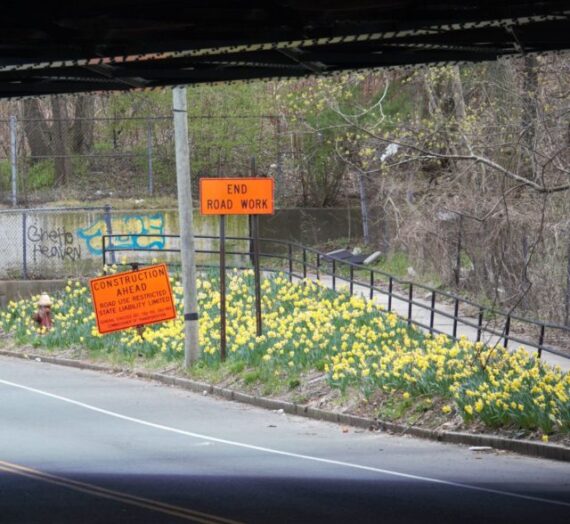The most interesting ideas of last evening’s One City, One Plan POCD meeting arose during the small group discussions. The meeting was held in the Connecticut Science Center.
A theme throughout several of the group discussions was that of sustainable design, planning, zoning, and ordinances. If a person, organization, or business wants to make better environmental choices, the system does not always support these. For instance, one person pointed out that if he wants to compost food scraps, he could be penalized if someone rats him out. A few months ago there was a push to modify a city ordinance regarding composting.
Some participants favored increasing taxes on surface parking lots, providing incentives for businesses to take more sustainable measures, and making it more difficult to remove vacant buildings, particularly historic ones. When buildings are torn down, one suggested that the city salvage and reuse the building materials. As another person pointed out, the most green building is the one that already exists; in other words, rather than adopting the “green lite” mentality and creating new structures, which requires an enormous amount of resources, we should use the ones that have already been built, even if that means retrofitting when necessary.
Another point that was raised was that of recycling. While the single-stream recycling program has been successful, it is not available for all city residents; furthermore, recycling is not enforced for corporate entities. Apartment buildings above a certain number of units do not have single-stream recycling. They often have no sensible recycling system. One building, for example, in the West End, has hundreds of units and a scant four recycling bins. Three of those bins have been sealed shut with a metal device. A groundskeeper was spotted removing cardboard and other recyclables from the one remaining bin and throwing it into the dumpster. Even if the residents are on board with the idea of recycling, many can not because they rent in buildings such as this. As someone pointed out, kids might learn how to recycle at school, but when they get home and can not practice it, there is a disconnect. People want to do the right thing– stop creating obstacles!
Others envisioned “complete neighborhoods” in Hartford’s future. This idea, modified from that of complete streets, would include neighborhood centers, schools and libraries with longer hours, the ability of adult community members to use gymnasiums after school hours, and enough jobs, grocery stores, entertainment, and other retail nearby to sustain the neighborhood. The concept of people living close to their jobs seemed popular, as was the idea of having jobs in the neighborhoods. Several participants wanted cars to become superfluous in Hartford.
Residents and participants seemed concerned with sustainable jobs and schools. The need for potential employers to recognize the skills of Hartford residents was mentioned, as was the need to remove “false requirements” from job applications, like having personal transportation or certain degrees. One community member emphasized that we should not think of jobs and the environment as mutually exclusive things. As for schools, it was noted that they should be sustainable from the structure to the lesson plans; I would add to this that cafeterias should utilize locally sourced food. Some promoted the idea of gardens and farms on school grounds as a way to both produce food and to teach youth practical, sustainable skills.
One of the best ideas that I heard was to “Undo the Stupid Stuff!” which referred partly to I-84/I-91 through Hartford, but other poor choices the city has made/allowed in the past few decades. Although some folks still believe that being critical of mistakes in the recent past is a way of interfering with progress, this mindset is becoming less and less popular. The often mocked idea of daylighting the Park River is actually looking like it may at least receive a compromise, in the form of a water feature in Bushnell Park. People are critiquing projects which at one time promised either convenience or money, yet delivered a reduction in quality of life for many, less revenue than anticipated, and other negative consequences.
Panelist Matt Fleury, the CEO of the Connecticut Science Center, described some of the building’s sustainable features, such as its new fuel cell. Information from the CT Science Center website describes this new feature:
On December 4, 2009, the Connecticut Science Center became the first science center or museum in the country to generate the majority of its energy needs on-site with a fuel cell.[…] During operating hours, the fuel cell provides approximately two-thirds of the needed power for the downtown Hartford destination. When the Science Center’s power demand is less, the 200-kilowatt fuel cell transfers energy back into the power grid system. The cumulative effect will result in almost 100% of the energy used being created by the clean, environmentally-friendly energy source. As an added benefit, the fuel cell will provide back-up power.[…] Fuel cells combine hydrogen and oxygen in an electrochemical process to produce electricity, heat and water. A hydrogen-rich fuel is derived from natural gas in a non-combustion process called reforming.
Additionally, the new center is expecting a “Gold Level LEED (Leadership in Energy and Environmental Design) certification from the U.S. Green Building Council (USGBC).” The venue seemed like an appropriate choice given the meeting’s subject matter.
Although many of the topics listed in this file were not discussed by participants (no interest? no expertise? not priorities?), they are worth reading through.
Here is a copy of the press release sent on behalf of the mayor’s office:
(December 8, 2009)— The fifth panel discussion of Hartford’s Plan of Conservation and Development (POCD 2020) once again drew a big crowd— this time to the newest jewel in Capital City’s crown— the Connecticut Science Center. Mayor Eddie A. Perez congratulated panelists and residents for their valuable participation.
“These community conversations are healthy discussions about what Hartford can be in the year 2020. You have brought diverse points of view to the table and by putting in your two-cents, we are truly becoming one city with one plan and one voice for Hartford,” said Mayor Perez.
Tuesday evening’s event was held overlooking the Connecticut River and holiday lights. The theme focused on promoting and encouraging the integration of sustainable practices. Topics included: green building and urban design, our natural environment, green jobs and technology, clean and renewable energy management, waste reduction, transportation and environmental health. The break-out sessions went into further detail: promote LEED standards to address energy savings; require new commercial construction over 50,000 square feet to be LEED certified silver; update building codes and design guidelines to promote rain gardens and green roofs; complete a city-wide tree canopy assessment; work with major corporations to explore the City as a center of energy efficient technology; encourage employee energy conservation and promote these practices at school; evaluate waste source reduction and reuse; continue single-stream recycling and composting; provide discounted rates for alternative fuel vehicles.
“We have come a long way with this series of discussions and what is great is that the process is not over yet. I encourage this dialogue to continue with renewed energy in the New Year. This gives time to digest your comments and make revisions so we can talk more at neighborhood based listening sessions to create a 20-20 foresight vision for the City,” said Mayor Perez.
Save these dates for the Planning and Zoning Commission’s Community Listening Sessions:
1. Thursday, Feb. 4 at 7pm at the Metzner Recreation Center, 680 Franklin Ave.
2. Tuesday, Feb. 9 at 7pm at the United Methodist Church of Greater Hartford, 571 Farmington Ave.
3. Thursday, Feb. 11 at 7pm at Pope Park Recreation Center, 30 Pope Park Dr.
4. Tuesday, Feb.16 at 7pm at Parker Memorial Community Center, 2621 North Main St.
The plan will be presented to the Court of Common Council by February 26, 2010. The target date for completion is June 1st.
One City, One Plan (POCD 2020) community conversations are now airing on Government Cable Access Television Channel 96 which also streams live on www.hartford.gov.


Stephen Grout
Rock on grrl. Btw, huge KRS-1 fan.